
Reprinted with permission from the Spring 2017 issue of the Utah Music Educators Journal.
Intro
How and by what system can we play brass instruments effortlessly and with a representative tone, ease of flexibility, and increased endurance? This has been a question that many of us have asked throughout our performance and education careers. After more than 30 years of teaching, performing and experimenting with different approaches, I was still not satisfied with the answers I found. I researched and tried many different embouchure placement and tone production techniques: mouthpiece-buzzing, use of the B.E.R.P. (buzz extension and resistance piece), free buzzing and others. Coupling these systems with breathing exercises was to no avail, since the results were not satisfying. Many of my students and I continued to struggle with tone, range and endurance issues. But then I witnessed a master class by Allen Vizutti, one of the world’s greatest trumpet virtuosos that permanently altered my way of playing and teaching. After he demonstrated and discussed his playing techniques, we had a lengthy conversation. He shared with me his reasoning and execution of the smooth air and no buzz techniques.
At first, I was somewhat skeptical whether or not these techniques would actually work, but I was willing to experiment with them. Immediately after our discussion, I incorporated his techniques into my own playing, and then I shared them with all of my brass students. Eureka! My playing became almost effortless, as did my students’, who showed remarkable progress within days. My ensembles sounded darker and richer, and our intonation control and endurance was greatly improved.
But even with these successes, I still harbored the following burning questions. How does this technique actually work? What are the physical mechanisms that make this work for brass players at any level? How can I teach this to students and colleagues and support it with evidence? These questions subsequently led me to investigate tube physics, air jets, oscillators and any topics that could provide answers and evidence for the smooth air and no buzz techniques. What follows is a summation of this scientific information and some practical applications to teaching and performing.
Misconceptions about brass playing vis-à-vis Concept from Physics
There are several misconceptions about how musical tones are produced with brass instruments. Most of these cluster into three categories: 1) embouchure mechanics, 2) mouthpiece function and 3) tube mechanics. Table 1 lists these misconceptions.
|
Most of these misconceptions have evolved from practical experience. For example, one’s lips feel like they are buzzing when they play. It is intuitive, then, to conclude that the buzzing is the cause of the tones being produced. But it will be shown that the lip buzz sensation is not a cause but an effect of several factors: air jets, pressure changes in the mouth cavity, strong turbulent eddies in the mouthpiece, a frequency feedback loop to and from the lips, and mouthpiece cavity resonance.
Another example is the technique of placing and sealing lips into the mouthpiece. It naturally seems that the cup “captures” a pitch created by buzzing lips. It will be illustrated that this is false. Instead, smooth (laminar) air flows between the lips & into the mouthpiece, which produces Aeolian tones and maximal resonance of the mouthpiece cavity. These actions excite the harmonics of the standing airwave in the instrument to sympathetically resonate. In effect, the air column resonates in a similar fashion to a string on a piano.
So what insights does acoustical science give us? Table 2 lists the brass instrument sound production concepts viewed from the perspective of physics.
|
Air Jets & Oscillators, The Embouchure Effect
What happens in the mouthpiece to produce a musical tone? Closed lips are placed against the rim of the brass mouthpiece. Air is forced between the closed lips. The air dramatically increases speed. This is called an air jet in physics, which usually describes a nozzle or tube from which a directed pressurized jet of air is emitted. This causes a change in lung air pressure at the point of the aperture (the distance of opening between the lips). Here the Bernoulli Principle takes effect. The same effect takes place over vocal folds when one sings. William Vennard, in his book Singing: The Mechanism and the Technic, wrote,
“The lips hold back the breath until its pressure becomes greater than their tension. Then a minute puff of air escapes, reducing the pressure to the point where the lip tension can stop the flow of breath again. This process, which is cyclical, or pendular, repeats itself hundreds of times per a second as long as the breath pressure can be maintained. This is called the “buzz” principle of embouchure. Many fine brass players prefer a different concept, which I believe is based on the Bernoulli Effect. This is a kind of suction which is created when air is in motion, and which is a factor in drawing the lips together again after they have separated… If one emphasizes the aerodynamic effect which Bernoulli described, it results in a more delicate adjustment of the embouchure, and consequently a more subtle tone with no loss of power and other requisites.” (pg. 15, paragraph 55, Singing: The Mechanism and the Technic, William Vennard, Carl Fischer, NY, NY. 1967.)
The air expelled from the lungs to the aperture is considered for practical purposes laminar air (smooth air). At the aperture, also known as the transition, the lips oscillate and turbulence is created because of the air pressure change and the reflection of moving air against the inside surface of the mouthpiece cup. Players feel a buzzing sensation at this point, but the buzz is merely an effect of the pressure differentials between the buccal (mouth) cavity and the mouthpiece.
Oscillation is a term that describes back-and-forth swinging of an object (lips in this case) in a regular, periodic motion. This creates turbulent eddies & back pressure in a mouthpiece cup. The sonic result is the generation of Aeolian tones.
An Aeolian tone is produced when air passes over an obstacle, resulting in trailing vortices or eddies (circular patterns of rotating air with reduced pressure). These occur with a very rapid oscillatory (back-and-forth) behavior. These eddies can have strong periodic components, resulting in a steady tone. This is the whistling sound one hears when there is a slightly opened window or door. (https://en.wikipedia.org/wiki/Aeolian_sound) See figure 3.

Cavity Resonance & Cavity Pop
Cavities with an open end have a natural frequency. Think of the pitch of a soda pop bottle when air is blown over the opening. All brass mouthpieces have a cavity resonance known colloquially as a “cavity pop.” Take a brass mouthpiece and cover the opening of the shank with a thumb. Lightly slam the cup of the mouthpiece into the palm of the other hand. By doing this, one can hear the pitch of the mouthpiece. This is its cavity resonance or pop. This cavity resonance when coupled with Aeolian tones from the aperture excites the air molecules open tubing of the instrument. These molecules, known as the standing wave, resonate in a similar manner to a string and produce harmonic tones. The higher the Aeolian tones are, the higher the frequency at which the standing wave of air will resonate. We hear these tones as musical pitches.
Resonance in a Tube Closed at One End
All brass instruments are considered tubes closed at one end, the embouchure. When the air inside them is excited by Aeolian tones they will resonate like the strings on a piano. The mouthpiece and flared bell are required to regulate the air column to produce the harmonic series we hear in all brass instruments. The mouthpiece lowers high tube resonances and the bell raises lower tube resonances. Without a flared bell and mouthpiece, no octaves or useful harmonics are generated. The bell also radiates sound and amplifies the lower timbres of the instrument.
Putting It All Together
The whole mechanism of producing musical tones on brass instruments is a function of the transfer of laminar air to turbulent air to create pressure changes that cause the air in the instrument to resonate. Figure 4 shows a graphic representation of these processes. Table 3 lists the step in order.
|
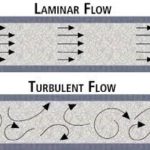
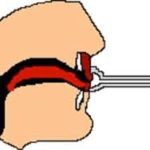
Lip Oscillators & Mouthpiece Effect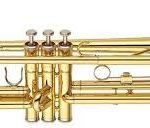
Standing Wave Air Column (Like a string) around the leadpipe, follwed by bell effect at bell.
|
In short, buzzing has no positive effect on tone production. It is merely a sensation felt on the lips due to air pressure changes. An effective experiment one can try is to simply blow air into a mouthpiece while inserting it in a brass instrument. The result is the Aeolian tone Mouthpiece Effect. No buzzing is ever needed. One can also try the opposite. Buzz into a mouthpiece while inserting it. Do not alter the buzzing in any way. The resultant sound is kazoo-like and uncontrolled. A comparison of the muscular positions and tensions of the buzz and smooth-air techniques yields some interesting results. The photo and spectrographs, which follow, illustrate those results.
Buzz & Smooth-Air Techniques Comparison
The pictures shown below are side-by-side comparisons of the buzzing and the no-buzz techniques.


Anterior View
In the anterior view, shown above, one can see the stark differences in tension at the corners of the mouth. The buzzing technique creates a “smiling” effect and actually promotes air leakage. The smooth air position, as if blowing through a straw, is more relaxed and uses the lower muscles from the chin area to help control the aperture size. The buzzing technique tends to stretch the lips. The smooth air technique keeps them relaxed and supple.
The lateral views shown below illustrate several other differences. Buzzing produces upper lip protrusion with an uneven lip position.
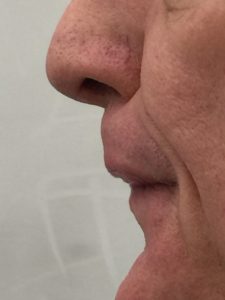
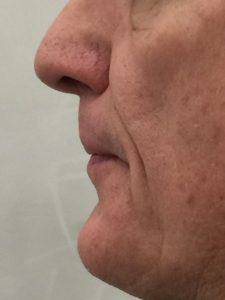
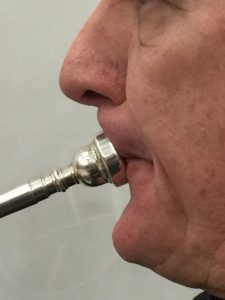
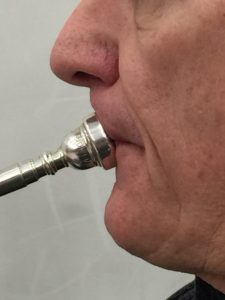
Buzzing makes aperture focus and sealing difficult. When buzzing, there is a natural reflex to push the mouthpiece back into the lips against the forward pressure of the embouchure to seal the lips. Conversely, the smooth air position sets the lips more evenly. Aperture focus is easier, and the seal is more natural. This “M” position of the lips is also very comfortable. In the two pictures below, one can see several differences. The smooth air technique promotes even laminar airflow and less tension.

|

|
Figure 5, shown below, is a spectrographic comparison of a Euphonium student playing an F3. The picture on the left shows a disruption of the overtones produced when the player used a buzzing system. The picture on the right shows how consistent the overtones are when using a smooth air technique.
|
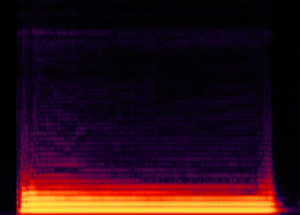
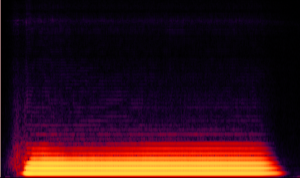
Euphonium Sample Recorded by Tyler Twogood at Weber State University Music Laboratory, Jan. 12, 2017.
Practical Applications to Teaching & Performance
- Always incorporate breathing exercises into every practice session. This promotes more lung capacity and the ability to produce steady laminar air.
 Straw Blowing to achieve laminar (smooth) air. This is one of the most beneficial exercises a brass player can perform. Place the straw between the lips. The straw should make no contact with the teeth. Simply practice blowing long phrases/tones into the palm of the hand. Concentrate on steady smooth air. Follow this immediately by blowing into the instrument. The results are remarkable. One can see and hear immediate improvement. This is very beneficial for students who are currently having difficulty with tone production.
Straw Blowing to achieve laminar (smooth) air. This is one of the most beneficial exercises a brass player can perform. Place the straw between the lips. The straw should make no contact with the teeth. Simply practice blowing long phrases/tones into the palm of the hand. Concentrate on steady smooth air. Follow this immediately by blowing into the instrument. The results are remarkable. One can see and hear immediate improvement. This is very beneficial for students who are currently having difficulty with tone production.
- Make an “M” for embouchure formation. The “M” position of the mouth, as in the word “mom”, is the most natural brass embouchure. It places the lips in a very relaxed and supple position for smooth air production.
- More closed M for higher notes, open for low notes. This is a productive method for register change. Tighten the “M” as if one is squeezing a straw between the lips. This can be practiced with the straw ahead of time. Emphasize steady air when shifting to the next overtone.
Results
One will see dramatic positive results using the smooth-air technique. They include: better tone quality, ease of playing, better intonation, faster learning, more dynamic and range control, and ease of learning articulations. Understanding the science behind tone production of brass instruments coupled with the incorporation of the smooth-air, no-buzz technique has transformed my students’ and my playing. To quote Allen Vizutti,
“Three words have led more brass players astray than any other common misconception. …The three little words are: “Buzz your lips.” Allen Vizutti, Basics for Beginning Brass.























